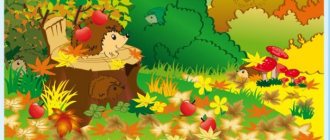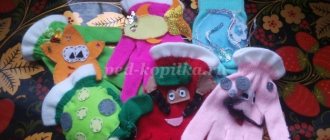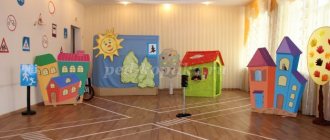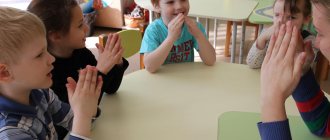Preparatory group. Senior preschool age. Children 6-7 years old
Development of communication abilities with peers in children 5–6 years old through dramatization games
DEVELOPMENT OF COMMUNICATIVE ABILITIES WITH PEERS IN CHILDREN 5-6 YEARS OLD
THROUGH DRAMATIZATION GAME Daria Igorevna Zazernaya Student of the Novosibirsk Pedagogical College No. 1 named after A.S. Makarenko, Novosibirsk Scientific supervisor: Tatyana Sergeevna Fomina Playing in preschool age.
Dramatization of the fairy tale “Teremok in a new way” with the participation of children from the preparatory group Goal: To develop the creative abilities of children through participation in theatrical activities. Objectives: 1. To introduce theatrical art; teach to understand different images of heroes and learn to move with the character of the music, performing dance elements. 2.Develop children's skills.
Publication “Fairy tale-dramatization for children of senior preschool age “Autumn in. » “AUTUMN IN THE FOREST” Fairy tale-dramatization for children of senior preschool age Author: Kuleshova T.Yu. teacher-speech therapist MBDOU "Kindergarten No. 117" Ryazan Characters: Autumn Hedgehog Squirrel Badger Hare Autumn comes and sings: All the animals know me And they call me Autumn. And after the red summer of Mine.
Dramatization of the Bashkir fairy tale “How the bear made friends with the bees” with children of the preparatory group Goal: To instill love and interest in the Bashkir folk tale. Objectives: Educational: Expand children's knowledge about Bashkir folk tales, retell them based on illustrations, name the heroes of fairy tales, dramatize them through different types of theater. Form ideas.
Summary of a lesson on speech development with elements of dramatization of the fairy tale “The Three Bears” for senior preschool age Development of speech with elements of dramatization of the fairy tale “Three Bears”, in the preparatory group. Goal: To develop the ability to conduct a basic dramatization of an already familiar fairy tale, to accurately reproduce the characters’ lines. Objectives: 1. Teach children to imitate the characteristic actions of characters.
The article “A differentiated approach to the development of dramatization play in boys and. » The development of a preschool child occurs only in activity, therefore the Federal State Educational Standard for Education proclaims the activity approach as one of the leading and determining strategies for preschool education at the present stage. The basis of this strategy is “supporting children’s initiatives in.
Game-dramatization as a means of developing reflection in children of senior preschool age “Game-dramatization as a means of developing reflection in children of senior preschool age” The problem of developing human reflection is one of the complex, multifaceted and has not yet received sufficiently complete and comprehensive coverage. Reflection analysis.
Dramatization games as a means of developing humane relationships with peers in children of senior preschool age One of the tasks of our time is to increase the level of morality and humanization of relationships in society. The implementation of this task leads to the need to improve moral education at all levels of education.[38] According to R.S. Bure, S.A. Kozlova, A.V.
Scenario for dramatization of the fairy tale “The Tale of the Trees” for the preparatory group Purpose: to create conditions for the development of children’s creative activity in theatrical activities; develop the ability to behave freely and relaxed when performing, to encourage improvisation through facial expressions, expressive movements, and intonation. Objectives: To educate children.
Source
Why do you need to dramatize a fairy tale in kindergarten?
It is difficult to overestimate the importance of theatrical activities in a preschool educational institution. In the process of learning and showing the production, the child is raised, morally and physically. Children come to kindergarten to join society; they must learn to speak in public, memorize text, and get involved in gaming or work processes. The teacher’s task is to conduct an interesting game, inserting a cognitive element into it and arousing interest among young actors. Dramatizing a fairy tale in a preparatory group helps show children how they can and cannot behave in different situations.
Matinee in kindergarten
Important! Performances in kindergarten are carried out in accordance with the Federal State Educational Standard, according to the approved program. You can choose well-known fairy tales, such as “The Clapping Fly” or “Little Red Riding Hood,” or show your imagination and stage an unusual production.
The easiest way to introduce a preschooler to national culture is through Russian folk art. At the age of 5, children absorb the wisdom and beauty of fairy tales like a sponge, let everything pass through them, and for the first time think about what is good and what is bad.
Another, no less important goal is aesthetic education. Staging Russian folk works allows you to:
Children from the younger group can prepare a fairy tale and role-play it. A New Year's or autumn party is perfect for this. You can also prepare a fairy tale for the holiday for mothers and for the autumn holiday. In general, 3-5 dramatizations can be prepared per year.
Note! The performance should not last longer than 15 minutes. Children who go to kindergarten are not yet ready for long performances. Dramatization is primarily a game, which means kindergarten students can laugh, dance and chat happily with each other.
Organization of theatrical activities with children of the preparatory group
Olga Sandul
Organization of theatrical activities with children of the preparatory group
Theater is a magical world.
He gives lessons in beauty, morality, and ethics.
And the richer they are, the more successful the development of the spiritual world of children is.
B. M. Teplov.
Goal: the formation of artistic creativity and the development of coherent speech in children through theatrical activities .
Tasks:
- learn to expressively pronounce phrases that carry different emotional connotations;
— teach children to combine movements and speech, analyze a lost situation;
- develop coherent speech, pantomimic skills, hand motor skills, fantasy, imagination, artistic taste, creative and acting abilities, the ability to improvise, the ability to express oneself in a situation of free choice, activation of the vocabulary
- to form an active position (the desire to take on a role, understanding the need for good relationships between people, heroes of fairy tales;
-contribute to the formation in children of readiness to resist evil;
- to cultivate a love for theatrical art .
Form of organization : group (work in small groups , individual, pair work.
A differentiated and individual approach, using a variety of techniques:
- children can choose a role at will ;
- appointment of shy children to the main roles;
— distribution of roles by cards
- playing roles in pairs.
— equal involvement of all children in activities .
In preschool childhood, the leading, most accessible and understandable type of children's activity is play . In play, the child develops, learns about the world around him, coordinates his interests and the interests of his play partners, and the child’s speech development occurs. The most popular and exciting area of play activity for preschoolers is theatrical activities .
From my experience, I saw that children really love to play “ theater ”. Namely, the plot of which is well-known fairy tales. Moreover, in some cases, children themselves portray characters from fairy tales, in others, toys and dolls become characters. Very often children improvise and come up with their own fairy tales. , the teacher himself plays a huge role in , who skillfully directs this process. It is necessary that the teacher not only be able to see , listen and hear, but also be ready for any “transformation”, that is, master the basics of directing skills. This is what leads to an increase in his creative potential and helps to improve children’s theatrical activities .
In my work with children in theatrical activities, I used the following methods:
1. Listening and playing short ethical tales, fables and poems that reveal moral categories and moral concepts children Children emotionally experience the content of a fairy tale, and then creatively reflect the events taking place in it through the heroes of the fairy tale. This method gives me the opportunity to subtly influence the personality of an older preschooler. Children acted out such ethical fairy tales and fables as “The Dragonfly and the Ant”, “Two Goats”, etc.
2. Creative tasks aimed at acting out life situations to form a positive image of a girl/woman (kind, smart, hard-working, responsive to the grief of others, caring for loved ones) and a boy/man (strong, brave, dexterous, resourceful, capable of protecting their loved ones ). Children were asked to complete various creative tasks, for example:
-show how “dad” gives “mom” flowers and says nice words to her
-show how “mom” dresses up “dad” for the holiday
-say on behalf of “mom” the phrase “Why didn’t you put away your toys?” - indignant, surprised, sad, quiet, loud, conveys by posture what he is doing at the moment
3. Games and exercises aimed at increasing the significance and uniqueness of each child. For example, in the “Bragging Competition,” I explain that the winner is the one who brags best, not about his own merits, but about the successes of his neighbor on the right. I suggest you look carefully at your neighbor, think about what he is like? What does he do best? After everyone had bragged, we talked about who liked what - bragging about their neighbor or listening to people talk about him.
4. I use the fairytale therapy method to develop creative initiative, the ability to overcome childhood fears, to reduce anxiety and aggressiveness, and to accumulate positive communication experience in a group of peers. For example, she offered to listen to the horror story “The White Piano” and asked them to draw their “fear”; the children drew dogs, snakes, spiders, etc. Then we tore them into small pieces and put them in a balloon, lowering it onto the street, thereby overcoming your fears.
5. Feedback method or (reflection)
which is aimed at displaying the emotional attitude of children to the event.
It is the theater that comes to kindergarten. After watching, I suggest having a conversation where the children tell their impressions and display more memorable events in their drawings. All these methods can be used at different times, both in the first half of the day - before the main educational activity , before lunch, before a walk, and in the afternoon. In the role-playing game “Let’s go to the theater ,” children enjoy making posters and invitation cards.
Theatrical activity retains all the structural components of the role-playing game:
• role
• game actions
• playful use of objects
• real relationships
To captivate children with art, to teach and understand beauty is the main mission of the educator and music director. It is art ( theater )
encourages in the child the ability to think about the world, about himself, about responsibility for his actions.
Children in the pre-school group are interested in theater as an art form . They are fascinated by stories about the history of theater and theatrical art , about the internal arrangement of the theater room for spectators (foyer with photographs of artists, wardrobe, auditorium, costume room, dressing room, art workshop). Children also get acquainted with theatrical professions (director, actor, make-up artist, artist, etc.)
.
Preschoolers already know the basic rules of behavior in the theater and try not to break them when they come to a performance. Special games - conversations, quizzes - help prepare them for visiting the theater For example, the conversation “Rules of conduct in the auditorium.” Acquaintance with various types of theater contributes to the accumulation of theatrical impressions , mastering the skill of understanding them and aesthetic perception.
A dramatization game often becomes a performance in which children play for the audience, and not for themselves; they have access to director's games, where the characters are dolls obedient to the child. This requires him to be able to regulate his behavior, movements, and think about his actions. Children continue to act out small stories using different types of theater : tabletop finger theater, with masks, etc., they come up with and act out dialogues, expressing intonation the characteristics of the character and mood of the hero.
In the preparatory group, an important place is occupied not only by the preparation and performance of the performance, but also by subsequent work. The degree of assimilation of the content of the perceived, acted performance is determined in a special conversation with children , during which opinions are expressed about the content of the work, characteristics of the acting characters are given, and means of expression are analyzed. At this age, children are no longer satisfied with ready-made plots - they want to invent their own and for this I I adhere to the following conditions:
• encourage children to create their own crafts for the director’s theatrical board game
• introduce them to interesting stories and fairy tales that will help them create their own ideas
• give children the opportunity to reflect ideas in movement, singing, drawing
• show initiative and creativity as a role model.
Special exercises and gymnastics that preschoolers do themselves help improve individual elements of movements and intonation. They come up with and assign some image to their peers, accompanied by gestures and facial expressions. The work is structured: reading, conversation, performance of passages, analysis of the expressiveness of reproduction. It is important to provide children with more freedom in action and imagination when simulating movements.
In my work on organizing theatrical activities, I took into account the forms of organizing theatrical activities , which include:
• theatrical games (to relieve emotional stress “Name your neighbor affectionately”, “Say a compliment”, etc.
• doll museum
• theatrical play at holidays and entertainment
• theatrical games in everyday life
• mini-games during music lessons
• theater in kindergarten
children visiting together with their parents (conversation)
• independent artistic activity
• joint theatrical activities of adults and children
While accumulating my experience, I also took into account psychological and pedagogical recommendations (Ermolaeva M.V.)
1. In theatrical activities, in close interaction with the development of creative abilities, it forms all aspects of the child’s personality, imagination, enriches the interests and personal experience of the child, and through stimulation of emotions forms the consciousness of moral standards.
2. Theatrical games should be of different functional orientations, contain educational, educational tasks, act as a means of the child’s mental processes, feelings, and knowledge of the world around him.
3. Approach the organization taking into account the age and individual characteristics of children, so that the indecisive ones develop courage, and the impulsive ones - the ability to take into account the opinion of the team.
In my educational activities I used such theatrical techniques as: characters are introduced that help children acquire certain knowledge, skills and abilities. The play form contributes to the emancipation of the child and creates an atmosphere of freedom and games.
With the help of a doll, you can create playful motivation for productive activity activities on behalf of the doll without the risk of causing offense or resistance.
A huge role in organizing theatrical activities is played by the teacher , who skillfully guides this process. The first theatrical games are conducted by the teacher himself, involving the children in them. Next, he uses small exercises and games in which the teacher becomes a partner in the game and invites the child to take the initiative in organizing . Thus, the following tasks are solved:
• development of creative abilities and creative independence
• fostering interest in various types of creative activities
• mastering improvisational skills
• development of all components, functions and forms of speech activity
• improvement of cognitive processes.
Theatrical activities can be included in all classes, joint activities of children and adults in their free time, and independent activities . In my experience with children, a lot of time is spent preparing for holidays and entertainment: how to act out a scene, how to read a poem with expression, etc. And in this case, children play an important role, where they become “actors” for their parents. In my work on organizing theatrical activities I use :
• games - dramatizations, where children play the role of an “artist” and independently create an image using a set of means of verbal and non-verbal expressiveness. Types of dramatization are games that imitate images of animals, people, and literary characters; role-playing dialogues based on text; staging of works; performances. Improvisation games with acting out a plot (or several plots)
without prior
preparation .
• director's games “artists” are toys or their substitutes, and the child organizes activities , controls them, “voices” the characters and, commenting on the plot, uses various means of verbal expression.
Thus, the organization of theatrical activities allows you to form the experience of social skills due to the fact that every literary work or fairy tale has a moral orientation (friendship, kindness, courage)
. Thanks to a fairy tale, a child learns about the world with his mind and heart. And he not only learns, but also expresses his own attitude towards good and evil. Favorite heroes become role models.
While organizing theatrical activities , I noticed that children solve many problematic situations indirectly on behalf of a character. This helps overcome self-doubt and shyness.
Allows you to develop memory, attention, imagination, initiative, independence and speech.
In the group where I work there is a theater corner with different types of theater - all the conditions for creating the development of children’s creative abilities. All inventory and equipment meet safety requirements for the life and health of students.
A daily tradition is reading fiction and educational literature, which allows children to figuratively introduce theatrical art , various children's works, which can become the basis for subsequent dramatizations. In the process of theatrical activities , I suggest playing outdoor games. During the game, children can show the habits of animals (according to the fairy tale “Teremok”, children willingly imitate animals with their voice and movement)
.
The children successfully use the experience gained during the game in independent activities . When organizing the lives of children in a group , the whole range of methods and techniques (visual, verbal, practical)
.
I believe that it is necessary to involve parents in the theatrical activities of children in a group , thereby trying to bring the family closer to the life of children in kindergarten. Together with parents, you can make decorations, attributes, masks, and noise-making musical instruments. In the corners for parents there are consultations on theatrical activities ; attraction to participation in leisure and entertainment. I believe that only if parents are active and interested, their personal example is the most important condition for ensuring the success of the organized work .
I believe that successfully solving problems in developing the creative abilities of preschoolers through theatrical activities is possible with close cooperation (teachers, children, parents)
.
In further work on organizing theatrical activities , I will continue to teach children manipulation techniques in puppet theaters of various types : to improve artistic skills in terms of experiencing and embodying the image, as well as performing skills; we will get acquainted with various types of theaters (puppet, drama, musical, children's, animal theater, etc. ); enrich their theatrical experience with knowledge about the theater and theatrical professions .
The results of the work on organizing children's theatrical activities in a group include the following: children become more emotional, more mobile; learn to understand art and express their impressions openly and honestly. A child who knows how to create an image on stage; transforming and expressing one’s emotions becomes an emotional, open, cultural and creative person.
For children, theater is a game , for parents it is a holiday, for teachers it is work. This work is done so that the theater can become a game and a holiday.
Bibliography:
1. Migunova E. V. “ Theatrical pedagogy in kindergarten”
, year 2009.
2. Gubanova N. F. “Game activities in kindergarten ”
, 2008.
3. Shchetkin A.V. “ Theatrical activities in kindergarten ”
, 2006.
4. Migunova E. V. “ Organization of theatrical activities in kindergarten ,” 2006.





